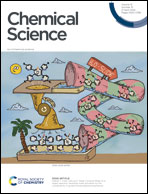Pendulum-like hemilability in a Ti-based frustrated Lewis Trio†
Abstract
We describe the first experimental example of a theoretically predicted Frustrated Lewis Trio (FLT). A tetradentate PNNP ligand is used to stabilise a highly electrophilic [TiCl3]+ fragment in a way that results in two equally long and frustrated Ti–P bonds. A combined experimental and computational approach revealed a distinct role of each Lewis basic phosphine in the heterolytic activation of chemical bonds. This dual functionality is characterised by a pendulum-like hemilability, where one of the phosphines acts as a nucleophile while the other serves as a hemilabile ligand that dynamically tunes the Ti–P distance as a function of the required electron density at the Ti centre.



 Please wait while we load your content...
Please wait while we load your content...